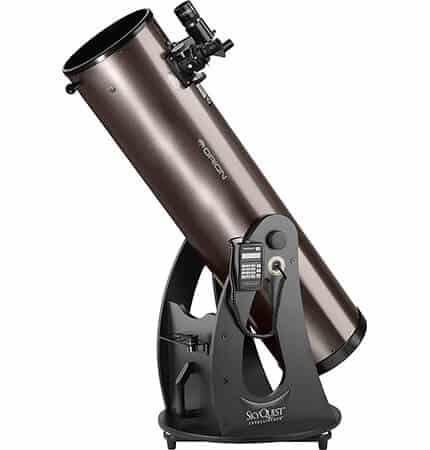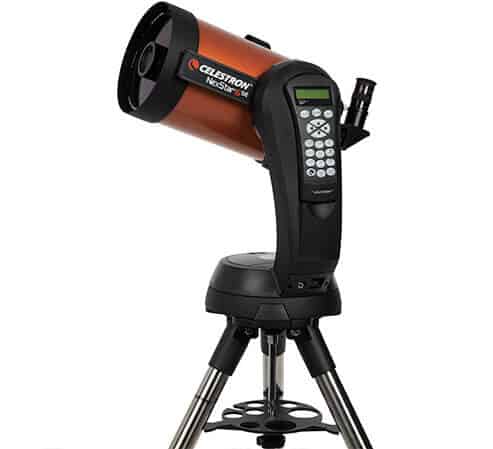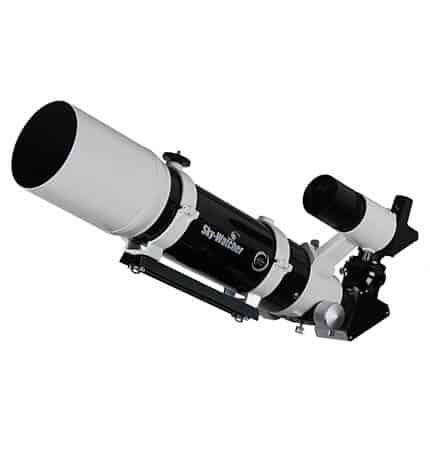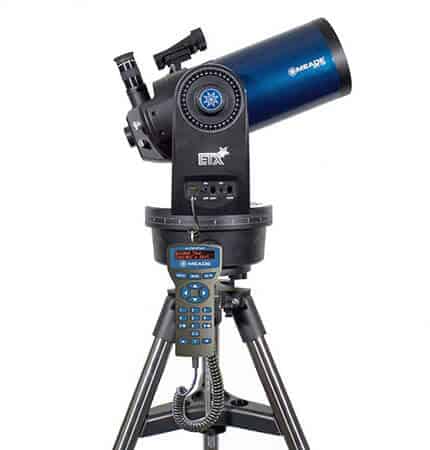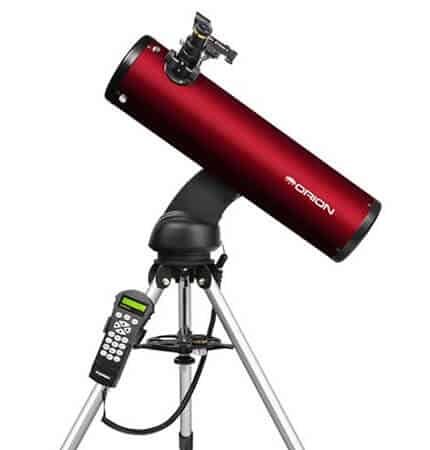Best Telescopes Under $1000
A Practical Buying guide for 2020
- Last Updated On:
Introduction
The tried and true method is to sort through hundreds of telescopes until you know exactly what you’re looking for. Fortunately for all of us, we can nowadays find the best telescopes for under 1000$.
Will it be like the stuff NASA uses? Of course not, but it will be far better than anything that Copernicus and Galileo worked with, so you might be the next one to get into the Hall of Fame of astronomers!
Quick Rundown
THESE ARE OUR TOP PICKS SUMMARISED FOR:
26th April 2024

- Big 10" (254mm) aperture
- Simple Dobsonian point-and-view

- 6-inch aperture with excellent light-gathering
- Fully automated GoTo mount

- 80 mm APO Refractor with ED Schott glass
- 600 mm focal length (f/7.5)
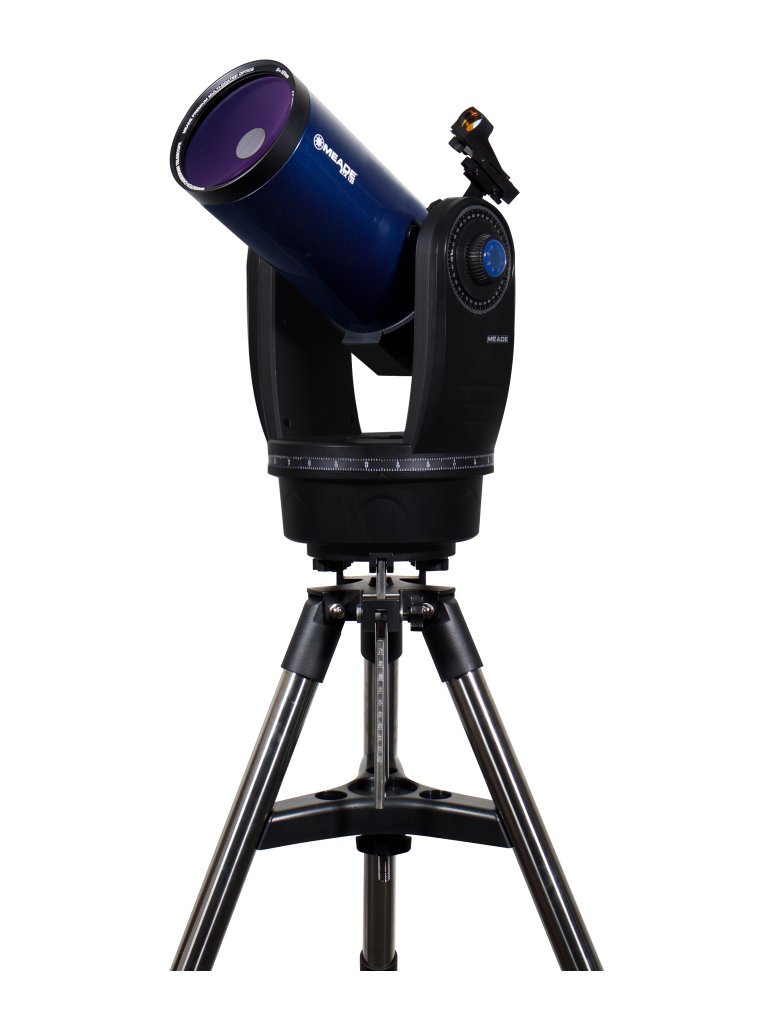
- Fully-featured GoTo telescope
- AudioStarcontroller

- Super-long 1540mm focal length
- Huge GoTo database of over 42,000 objects
Table of Content
What Makes a Great Telescope Under $1000?
Has an astronomy book by Lawrence M. Krauss inspired you to take a closer look at the planets and stars around us, or do you need a simple telescope for additional camping during the summer?
Whatever your reason might be for getting a telescope, be assured that you don’t need to spend a ton of money for a good tool.
The important thing is that you look out for some important features. Let us take a closer look at different types of telescopes that you can buy.
Refractors and Reflectors:
There are two basic types of telescopes that you can buy, namely refractors and reflectors. Both types use an objective that collects light, but the main difference between these two telescope types is the kind of objective that is used.
The refractor telescope use a glass lens as their objective. For the amateur astronomer, this is not a big problem, but glass is not the best material for massive telescopes because of lens sagging, the weight of glass and distortion of the pictures.
The most simple refractor telescopes are called Galilean telescopes. They have a somewhat distorted view and a narrow field of view, which makes them inconvenient for modern day practices. A big improvement is the Keplerian telescope, with much wider field of view and greater eye relief. They offer a higher magnification, but come with a big disadvantage – image for the viewer is inverted, both in terms of left-right and up-down.
Reflecting telescopes use mirrors instead of lenses, which eliminates a lot of problems that refractor telescopes have. The Newtonian telescopes offer the arguably best for amateurs, but note that some might find it weird to look an object in the sky from the side of the telescope. Models that fall into the Cassegrain telescope eliminate this problem, as well.
While it might be easy to dismiss all telescopes as inferior to Cassegrain telescopes, all of the different models and technologies have their own advantages and disadvantages. While some telescopes come with certain inconveniences, they might offer a better quality view with a bigger resolution for less money, for example.
Feautures of a Great Telescope
Besides knowing the different types of telescopes, you should be familiar with some of the more important features of a telescope. These will help you finding a telescope that will suit your personal needs and also help you identify the price-quality-ratio.
Aperture:
Most astronomers agree that aperture is the most important spec of a telescope, so this is the first thing you should look out for. Aperture is, in simple terms, diameter of its main, light-gathering objective. It doesn’t matter if the objective is a mirror or a lens, what matters is that a bigger objective creates a sharper and brighter image. This also means that a big aperture will allow you to identify fainter objects in the night sky.
Focal Length:
The focal length is the distance between the telescope’s objective and the point where the light rays come together in focus. The focal length determines the magnifying power of a telescope. The rule of thumb is that bigger focal length allows for bigger magnification. If you want to look at specific celestial objects, a bigger focal length might be more desirable, but if you want to look at solar systems or whole galaxies, a smaller focal length might be more of an advantage.
But problems with focal length don’t stop there. A huge focal length only makes sense if the aperture is high enough to begin with. Think about it this way – zooming into an image which has a low resolution will barely help you identify small object any better than not zooming in at all, but zooming into a picture with a high resolution is definitely helpful.
If you want to calculate the magnifying power of a telescope, you can do so pretty easy. You must need to double the objective’s diameter in millimeters. That means that a 100mm telescope would have a practical magnification limit of 200 times.
Portability:
Having a huge aperture and great focal length comes at a price, both in terms of money, but also in terms of portability. Some telescopes can be a bother to transport. Unless you, your parents or some friend has a car that you can use to transport larger telescopes, you should settle with some smaller telescopes. But maybe you will simply keep your telescope in your garden or on your balcony? Maybe in this case you can get away with a bigger telescope. This is something very individual, but maybe starting out with something moderately sized is preferable as you’ll be able to upgrade later on.
Mount:
Some telescopes come packaged with a mount and some don’t. Make sure to always double check whether or not your particular model ships with a mount. The mount is a platform for your telescope and it is connected to a tripod which offers stability and elevation for your telescope. This not only has an impact on comfort of use, but also on portability and stability.
A rule of thumb is that so-called alt-azimuth mounts are easier to use, good for beginners and lighter telescopes, while the equatorial telescope mounts are better for for heavier telescopes and for people interested in astrophotography. Some equatorial mounts are also computerized, helping you find what you are looking for in the sky, but this, of course, comes with a steeper price.

APERTURE
254mm
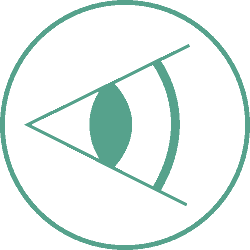
FOCAL LENGTH
1200mm

MOTORIZED
Yes

Mount type
Dobsonian
Overall:
Our number one telescope scrapes at the upper limit of our budget for this review, but it is definitely worth its money. The Orion 10019 SkyQuest is a Dobsonian telescope (an altazimuth- mounted Newtonian telescope).
This Dobsonian telescope is computerized and can help you find an incredible amount of celestial objects and formations. You still have to move the telescope by hand, but the coordinates are extremely helpful nonetheless.
Although is not a professional telescope, this titan of a telescope can be used to look at very far galaxies and nebulae because of its 254mm aperture reflector design. Close-ups of Saturn or the Moon are possible, as well.
The telescope comes with a great stand, tension adjustment knobs, two different eyepieces, a focal length of 1200mm, aperture of 10 inches (254mm) and the focal ratio of f/4.7.
The Object Locator requires a 9V battery.
- Very versatile
- Comes with a stable and adjustable stand
- Built-In Object Locator
- It is NOT a real GoTo telescope, so you have to keep moving it if you want to enjoy a closer celestial bodies for prolonged time.

APERTURE
150mm

FOCAL LENGTH
1500mm

MOTORIZED
Yes

Mount type
Alt-Azimuth
Overall:
The famous Orange Tube is a computerized telescope that will make stargazing one of the most fun things you will ever do. The GoTo mount is fully automated and has over 40000 celestial objects in it. It would take years to find all of them!
The specs of this telescope are completely amazing considering the relatively moderate price. It has a focal length of 1500mm, so what you are getting is a 150mm f/10 Schmidt-Cassegrain telescope.
The great features of this telescope do come with some drawbacks, though.
This is definitely not the most intuitive and easy-to-setup telescope on the market. If you have someone to help you with the alignment and to show you how to use it, you’ll be able to use it on your own in no time.
But if you are all alone, the somewhat old technology will make it hard to set it up properly. The AC Power Adapter is NOT included and is sold separately.
All in all this is a very affordable telescope that can later be upgraded to get the maximum efficiency out of it and it will require some learning, but if you want great specs for a low price, the NexStar 6 SE is the way to go.
If you can afford to spend a little more be sure to check it’s big brother the Celestron NexStar 8SE or check our buying guide about the best celestron telescopes.
- Very portable and great for taking pictures
- Able to find more than 40000 objects in the sky
- Fully automatic telescope with great features
- Updating the firmware on a Mac or Linux computer is challenging or straight out impossible

APERTURE
80mm

FOCAL LENGTH
600mm

MOTORIZED
No

Mount type
-
Overall:
The Sky-Watcher ProED is a great edition of affordable high-quality refractor telescopes. The 80 mm model is the most affordable one, but it is somewhat weaker than the bigger counterparts. We still think that this one is the best blend of quality and price.
The 80 mm APO Refractor makes use of ED Schott glass and combines with the 600 mm focal length into a great F/7.5 telescope. The ProED 80 mm model offers amazing optics and a lightweight design. It is a great telescope for wide-field astronomical observation of prominent nebulae or close-by galaxies, but it can be used as an astrograph for sky photography, as well.
Another strength of this telescope is that it virtually eliminates residual chromatic aberration, resulting in flawless colors.
This telescope doesn’t perform as well as some better ones in light-polluted areas, so getting out of the city is recommended. It comes without a tripod, so make sure to find something fitting before deciding on the purchase.
This might not be the strongest telescope on the market, but what you can see with it will still blow your mind.
- Budget friendly
- Good for beginners
- Easy and fast to assemble
- Capable for beginner astrophotography
- Not suited to see DSOs
- Primary reflector can come dirty
- Red dot finder awkward to use
- Collimation piece is difficult

APERTURE
127mm

FOCAL LENGTH
1900mm

MOTORIZED
Yes

Mount type
Alt-Azimuth
Overall:
The ETX125 is an amazing GoTo telescope that not only has a database of over 30000 celestial objects, but also a built-in speaker and over 4 hours of audio content used for educational purposes.
This great scope comes with a 127mm f/15 configuration.
It has a Maksutov-Cassegrain Optical Tube and an internal flip mirror system. This is a fairly portable telescope that will be a great tool for viewing close-ups of the moon, but of course, you can view galaxies and nebulae, as well.
The audio system makes it especially fun for younger users.
The telescope is not suited very well for taking pictures as there is not enough room between the rear port and the horizontal base.
You could maybe fit in a very small erecting prism or go with a smartphone, but the results will be less than optimal.
But if you are not into taking pictures and just want to look at the sky with your own eyes, the ETX125 is a great choice.
- Budget friendly
- Good for beginners
- Easy and fast to assemble
- Capable for beginner astrophotography
- Not suited to see DSOs
- Primary reflector can come dirty
- Red dot finder awkward to use
- Collimation piece is difficult

APERTURE
127mm

FOCAL LENGTH
1540mm

MOTORIZED
Yes

Mount type
Alt-Azimuth
Overall:
If you are searching for a great GoTo telescope with a huge database, then the Orion 13163 might be the best choice on the market.
It is very affordable and has a database of over 42,000 objects, a built-in tour mode and a system for manually aiming the telescope without losing the GoTo alignment.
The StarSeeker IV is a 127mm Maksutov-Cassegrain telescope with a 1540mm focal length and f/12.1 focal ratio.
Due to the weight being only 22.2 lbs., this might be the ideal Grab and Go telescope, especially if you want to take photographs, as well.
Conclusion:
The telescope comes without an AC power cable and without batteries. It can run on 8 AA batteries if you wish to use it like that, but getting an external power source is more preferable.
- Budget friendly
- Good for beginners
- Easy and fast to assemble
- Capable for beginner astrophotography
- Not suited to see DSOs
- Primary reflector can come dirty
- Red dot finder awkward to use
- Collimation piece is difficult
Conclusion
Hopefully our article was enough to give you a basic overview on what to look out for when buying an affordable telescope. Of course, there is more to every model than meets the eye at first glance, so without testing a huge number of models, you won’t be able to fully understand minor differences.
But what you should be looking for is either something versatile, or something that you don’t already own.
Always make sure to double check whether the telescopes come with a stand, tripod, AC adaptor or any other additional gear. Sometimes you can get into a situation where add-ons can increase your total cost far above what you would have spent for a good bundle that has seemed more expensive at first.
It’s crucial to pinpoint your priorities. Do you want to gaze mostly at galaxies and clusters, or at specific stars and planets? Do you need something stationary or something easy to move?
Make your choice not only based on online reviews, but also on your real life preferences. Be sure to check our other buying guides for telescopes under $500 and $300.
Now is your turn which affordable telescope would you recommend?
Make sure to share this article with your astronomy friends!
SUBSCRIBE TO OUR WEEKLY NEWSLETTER
